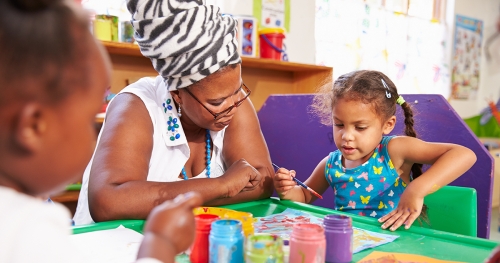A Conceptual Framework for Evaluating the Impact of Classroom Quality on Child Outcomes
Variations in Implementation of Quality Interventions (VIQI): Examining the Quality-Child Outcomes Relationship in Child Care and Early Education

Overview
The Variations in Implementation of Quality Interventions (VIQI): Examining the Quality-Child Outcomes Relationship in Child Care and Early Education project is a large-scale, rigorous study with several important aims and implications for current child care and early education policy and practices, including:
- Determining the effectiveness of interventions for strengthening classroom quality and improving a range of children’s learning and developmental outcomes;
- Identifying dimensions of quality within child care and early education settings that are key levers for promoting children’s learning and development;
- Identifying levels in dimensions of quality that are necessary to support children’s developmental gains;
- Identifying drivers that facilitate or inhibit successful implementation of interventions aimed at strengthening quality; and,
- Understanding how these relations vary across different child care and early education settings, staff, and children.
Prompted by converging evidence about the importance of early childhood for creating a foundation for lifelong success and concern that children from low-income and racially and ethnically diverse families tend to face greater risk for poorer outcomes than their higher-income peers, public support and government investments in child care and early education are at an all-time high. The field agrees that classroom quality matters for promoting child outcomes. Yet, there is considerable variation in the overall quality of services, with instructional quality — a key driver of children’s gains — often being low across programs nationally despite a focus on quality improvement at national, state and local levels. Indeed, there are still many open questions about how best to design and target investments to ensure that children, particularly low-income children, receive and benefit from high-quality child care and early education programming on a large scale.
There is a growing, but imperfect, knowledge base about which dimensions of quality are most important to strengthen, and what levels of quality need to be achieved to consistently promote child outcomes across child care and early education settings. The literature has identified several basic dimensions of classroom quality — such as structural, process, and instructional quality — that are hypothesized to promote child outcomes. Nonexperimental evidence portrays an intriguing pattern of correlational findings suggesting that quality may need to reach certain levels before effects on child outcomes become evident and that different dimensions of quality may interact with each other in synergistic ways to affect child outcomes. But existing evidence has not pinpointed the exact levels that are consistently linked with child outcomes. Further, there is a relatively little causal evidence showing that efforts to strengthen program quality will yield improvements in child outcomes. Without such rigorous evidence, it is difficult to draw policy and practice implications. What the field needs is a stronger, causal evidence base that provides a better understanding of the relationship between quality and child outcomes, the dimensions of quality that are most related to child outcomes, and the program and classroom factors that aid delivery of quality teaching and caregiving in child care and early education settings.
Additional Project Details
Agenda, Scope, and Goals
In line with this literature, VIQI aims to tackle these issues by unpacking the “black box” of quality and its drivers in child care and early education settings by addressing the following research questions:
- Do different dimensions of quality yield differential effects on child outcomes?
- Do critical levels in quality need to be met to promote gains in child outcomes?
- Do the effects of quality — different dimensions or levels — on child outcomes differ, depending on child, staff, and center characteristics?
Do initial levels of readiness/quality in centers require varying levels of support to benefit from quality improvement efforts?
Design, Sites, and Data Sources
The VIQI project aims to fill gaps in the literature by conducting a rigorous experimental study testing two promising interventions that consist of curricular and professional development supports and target different dimensions of classroom quality. The study will take place in Head Start and community-based early care and education classrooms that serve both three- and four-year-old children. In-depth information will be collected to test the effectiveness of the interventions and to investigate how different levels and features of classroom quality relate with children’s developmental outcomes. The VIQI project will also include an in-depth implementation study to understand the conditions necessary to plan, install, and implement an evidence-based intervention that will produce changes in the content of instruction; quality of teacher practice, instruction, and interactions with children; and child outcomes. In doing so, the VIQI project will be poised to build new evidence about the determinants and the benefits of high-quality programming across various settings.
VIQI is a multi-year project (2016-2023), which is being conducted in two key phases. The first phase entails a small, year-long pilot study to inform the implementation and feasibility of the two interventions for rigorously affecting different dimensions of quality. Insights from the pilot study will be used to refine the study design before a year-long, full-scale study. The projected sample for the full-scale study is 120 programs and 3,600 children. Multiple measures of classroom quality and child outcomes will be collected.






